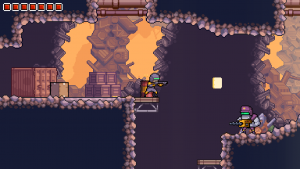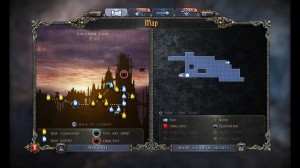The term “Metroidvania” has become a part of the video game vernacular over the years. Long since evolved from the days of Castlevania Symphony of the Night, it has become a catch-all for many action-adventure-based games. For today, we’re going to drill down and talk about the three essential elements that make up a Metroidvania game.
Foundation:
Despite ending strong, Metroidvania-designed titles always have to begin with the player at their weakest state. A classic situation is to start the player partially or fully upgraded, and remove their abilities after an event.
A common trap that designers fall into is to make the beginning as tedious and frustrating as possible to easily show the evolution of the character. This can include removing the ability to run, jump, or even any option to attack.
As we’ve talked about before, you don’t want your players to immediately have a bad experience playing your game. If you’re going to start the player without essential abilities, then quickly introduce them so that they can start playing the game for real. The core gameplay loop of your title should be solid from minute one.
A good metroidvania-based game will start off with the character controlling responsively and only get better from there. Titles like Axiom Verge, Omega Strike and Hollow Knight did not limit the base abilities of the player at the start.
With that said, let’s move on to powering up the player.
Upgrade Design:
An absolutely necessary part of metroidvania design is introducing upgrades to the character. While the act of powering up has been a mainstay of the action genre, metroidvania titles go a step further. Upgrades not only enhance the player, but fundamentally change how someone plays the game. Your core abilities in a metroidvania will grow over the course of playing. What that means is how someone plays the game will change from beginning to end.
When it comes to design, the sky is the limit for potential upgrades. I’ve seen games let the player teleport, infinite jump, sliding and so much more. While you can have stat-based upgrades like health, damage, etc, in order for the game to be a metroidvania there must be game-changing upgrades.
Another major point we have to talk about is the difference between upgrades and “keys.” It’s very easy to design an upgrade as a key: Where it will only be used in a specific section of your game and nowhere else. A good metroidvania game will design upgrades that fit into the player’s normal routine.
In return, the pathing through a level will change due to the player having more options for movement or combat. Better metroidvanias will allow upgrades to combine with each other for further improvement. A great example of this was the game Guacamelee that integrated upgrades into platforming and the combat system.
All the upgrades in the world won’t matter if the environment design doesn’t change to go with it.
Environment
For our final point, I want to touch on level/environment design. Metroidvanias by their design are meant to motivate and reward exploration. The world itself should be connected; allowing for multiple paths to and from important areas.
As the player gets further into the game, the obstacles should change to reflect the abilities and upgrades the player has unlocked. The most common example has to do with mobility. As the player becomes more mobile, level designs will start to place platforms further apart or higher up to make use of the additional options.
This is why a good foundation of upgrades is essential for metroidvania design, because they could be used as a source of inspiration for designing the areas.
Another important aspect of metroidvania design is having secrets to find. Secrets in metroidvania titles come in two flavors. The first are optional upgrades hidden in harder areas or off the beaten path. These secrets can usually be found by the discerning player without needing additional upgrades.
The second are bonuses explicitly designed to require the player to backtrack with the appropriate upgrade. These upgrades are designed to tempt the player, and allow them to see the difference in play on return.
Some of the better examples of Metroidvania will cut back on repetitive backtracking by allowing areas to be traversed differently depending on the player’s upgrades.
A platforming section won’t pose a problem if the player can now jump infinitely or fly for example. Fast travel stations are typically used in larger metroidvania games where backtracking can take upwards of 10 or more minutes in some cases.
Creating an attractive world that invites the player to explore and return to is a high mark for the Metroidvania genre.
Mastering Metroidvania:
The term “Metroidvania” has taken on a life of its own over the last decade with many games trying to market themselves around it. Good Metroidvania design is not something that comes easily, and requires all three elements to be on point.
The difference in quality of those that get it or don’t is striking. The Metroidvania sub-genre is one of my all-time favorites, and one that I’ve gotten quite good at spotting the greats from the misses. For you: What were some of your favorite and least favorite attempts at Metroidvania design?




